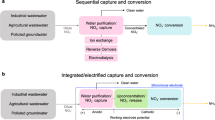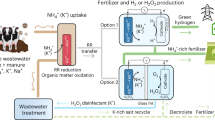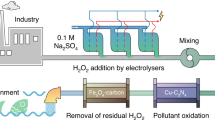Abstract
NITRATE, a common and serious contaminant of ground water, is removed at present either by physicochemical methods that do not degrade it, or via degradation by microorganisms, which is a slow process1. We report here a rapid and efficient process for nitrate removal which involves catalytic reduction by immobilized enzymes. The reduction is driven by an electrical current, and results in complete conversion of nitrate to N2 without residues. Our electro-bioreactor was constructed by co-immobilizing the enzymes (purified NADH: nitrate reductase from Zea mays2 and crude nitrite reductase and N2O reductase from Rhodop-seudomonas3) with electron-carrying dyes in a polymer matrix, which was then attached in thin layers to the surface of the cathode. Nitrate-laden water is pumped past the anode and through the active matrix on the cathode while a low voltage is applied, resulting in two-stage nitrate reduction to N2 via nitrite. The enzyme activity is higher in the co-immobilized state than in free solution. In principle, such electro-bioreactors could be developed for removal of other water contaminants such as pesticides, if appropriate enzymes and cofactors can be identified.
This is a preview of subscription content, access via your institution
Access options
Subscribe to this journal
Receive 51 print issues and online access
$199.00 per year
only $3.90 per issue
Buy this article
- Purchase on Springer Link
- Instant access to full article PDF
Prices may be subject to local taxes which are calculated during checkout
Similar content being viewed by others
References
Well, G. & Kalbertodt, S. Bioengineering 6, 21–31 (1989).
Hyde, G. et al. Plant molec. Biol. 13, 233–246 (1989).
Neu, H. D. & Heppel, L. A. J. Biol. Chem. 240, 3685–3692 (1965).
Mirvish, S. Nature 315, 461–462 (1985).
Eur. Chem. Industry Ecol. Toxicol. Centre Tech. Rep. 27, Brussels (1988).
Murphy, A. P. Nature 350, 223–225 (1991).
Michalski, W. P. & Nicholas, D. J. D. Biochim. biophys. Acta 828, 130–137 (1985).
Michalski, W. P. et al. Biochim. biophys. Acta 872, 50–60 (1986).
Hochstein, L. I. & Tomlinson, G. A. Ann. Rev. Microbiol. 42, 231–261 (1988).
Ferguson, S. J. Trends biochem. Sci. 12, 354–357 (1987).
Campbell, W. H. Physiol Plant. 74, 214–219 (1988).
Barber, M. J. & Solomonson, L. P. J. biol. Chem. 261, 4562–4567 (1986).
Campbell, W. H. Plant Physiol. 82, 729–732 (1986).
Registry of Toxic Effects of Chemical Substances, Natl. Inst. Occupational Safety and Health DW 2275000 (Bethesda, 1982)
Black, S. D. & Coon, M. J. Adv. Enzym. 60, 35–87 (1987).
Porter, T. D. Trends biochem. Sci. 16, 154–158 (1991).
Biebricher, C. & Luce, R. US Patent No. 4, 177038 (1979).
Urata, K., Shimada, K. & Satoh, T. Plant Cell Physiol. 23, 1121–1124 (1982).
Author information
Authors and Affiliations
Rights and permissions
About this article
Cite this article
Mellor, R., Ronnenberg, J., Campbell, W. et al. Reduction of nitrate and nitrite in water by immobilized enzymes. Nature 355, 717–719 (1992). https://doi.org/10.1038/355717a0
Received:
Accepted:
Issue Date:
DOI: https://doi.org/10.1038/355717a0
This article is cited by
-
Room-temperature hydrogen spillover achieving stoichiometric hydrogenation of NO3− and NO2− into N2 over CuPd nanowire network
Rare Metals (2022)
-
Data identity and perspectivism
Synthese (2021)
-
Effects of cycle duration of an external electrostatic field on anammox biomass activity
Scientific Reports (2016)
-
Combined autotrophic nitritation and bioelectrochemical-sulfur denitrification for treatment of ammonium rich wastewater with low C/N ratio
Environmental Science and Pollution Research (2016)
-
Using electric field to enhance the activity of anammox bacteria
Applied Microbiology and Biotechnology (2015)
Comments
By submitting a comment you agree to abide by our Terms and Community Guidelines. If you find something abusive or that does not comply with our terms or guidelines please flag it as inappropriate.



